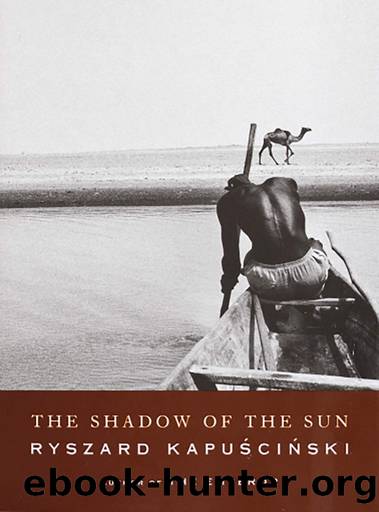The Shadow of the Sun by Ryszard Kapuściński

Author:Ryszard Kapuściński [Kapuściński, Ryszard]
Language: eng
Format: azw3
Tags: Travel, Africa, Nonfiction, Polish Literature
ISBN: 9780375413452
Publisher: Knopf Doubleday Publishing Group
Published: 2001-07-04T23:00:00+00:00
For the natives, however, the dramas are real, and the tragedies painful and not exaggerated. So it was in Rwanda. The revolution of 1959 divided the Banyarwanda nation into two opposing camps. From now on, the passage of time would serve only to strengthen the mechanisms of discord, sharpen the conflict, lead again and again to bloody collisions and, finally, to apocalypse.
The Tutsis, who have spread out in the camps along the borders, conspire and contract. In 1963 they strike from the south, from neighboring Burundi, where their kinsmen, the Tutsis of Burundi, hold power. Two years laterâanother Tutsi invasion. The Hutu army stops it, and in retaliation organizes a great massacre in Rwanda. Twenty thousand Tutsis die, hacked to pieces by Hutu machetes. (Other estimates put the figure at fifty thousand.) No outside observers are present, no international commissions, no media. I remember that a group of us, foreign correspondents, tried to get into Rwanda but were refused entrance by the authorities. We were reduced to gathering what information we could in Tanzania, from escapeesâmainly women with children, terrified, wounded, hungry. The men were usually killed first, did not return home from expeditions. Many wars in Africa are waged without witnesses, secretively, in unreachable places, in silence, without the worldâs knowledge, or even the slightest attention. And thus it was with Rwanda. The border skirmishes, pogroms, massacres go on for years. Tutsi partisans (called âcockroachesâ by the Hutus) burn villages and slaughter the locals. The Hutu villagers, in turn, supported by their army, organize rapes and massacres.
Living in such a country is difficult. There are still many villages and towns with a mixed population. Tutsis and Hutus live side by side, pass each other on the roads, work in the same place. And, privately, they conspire. Such a climate of suspicion, tension, and fear is fertile breeding ground for the old, tribal African tradition of underground sects, secret associations, and mafias. Real and imaginary. Everyone secretly belongs to somethingâand is convinced that everyone else, the Others, also belongs to something. And, naturally, the thing they belong to is a hostile, enemy organization.
...
Rwandaâs twin country is its southern neighbor, Burundi. The two have a similar geography and social structure, and a common history going back centuries. Their destinies diverged only in 1959: in Rwanda, the peasant revolution of the Hutus was triumphant, and its leaders assumed power, whereas in Burundi the Tutsis maintained and even strengthened their rule, expanding the army and creating something akin to a feudal military dictatorship. Nevertheless, the preexisting, almost organic connections between the twin countries continued to function, and the massacre of Tutsis by Hutus in Rwanda evoked a retaliatory massacre of Hutus by Tutsis in Burundi, and vice versa.
In 1972, the Hutus from Burundi, emboldened by the example of their brothers in Rwanda, attempted to stage an insurrection, slaughtering, for starters, several thousand Tutsis, who, in response, killed more than a hundred thousand Hutus. It was not the fact of the massacre alone, for
Download
This site does not store any files on its server. We only index and link to content provided by other sites. Please contact the content providers to delete copyright contents if any and email us, we'll remove relevant links or contents immediately.
Harry Potter and the Goblet Of Fire by J.K. Rowling(3045)
Unfinished: A Memoir by Priyanka Chopra Jonas(2918)
Never by Ken Follett(2880)
The Man Who Died Twice by Richard Osman(2299)
Machine Learning at Scale with H2O by Gregory Keys | David Whiting(2291)
Fairy Tale by Stephen King(2070)
Will by Will Smith(2042)
Rationality by Steven Pinker(1765)
The Storyteller by Dave Grohl(1660)
The Dawn of Everything: A New History of Humanity by David Graeber & David Wengrow(1571)
The Dark Hours by Michael Connelly(1570)
The Stranger in the Lifeboat by Mitch Albom(1532)
Cloud Cuckoo Land by Anthony Doerr(1434)
The Becoming by Nora Roberts(1330)
Friends, Lovers, and the Big Terrible Thing by Matthew Perry(1328)
New Morning Mercies: A Daily Gospel Devotional by Paul David Tripp(1323)
Crying in H Mart by Michelle Zauner(1316)
Einstein: His Life and Universe by Walter Isaacson(1315)
A Short History of War by Jeremy Black(1300)
